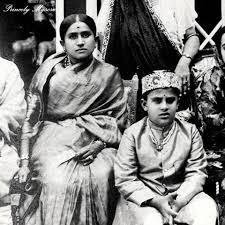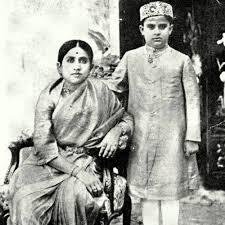The Influential Regent of Mysore: Maharani Lakshmivilasa Sannidhana Shri Pratapa Kumari

The Kingdom of Mysore, an illustrious geopolitical realm in southern India, boasted a history rich with transformation and resilience. Founded around 1399 in the area of present-day Mysore, this kingdom remained a prominent force in Indian history until its integration into the Indian Union in 1950. Its journey from a feudal vassal to a princely state, and through periods of dramatic political change, reflects its dynamic and influential role in the region.

Initially, the Kingdom of Mysore was a feudal vassal under the Vijayanagara Empire, which was one of the most significant empires in southern India during the late medieval period. The Wadiyars, a prominent dynasty, were central to the kingdom’s early history. For much of its early existence, Mysore functioned within the shadow of the Vijayanagara Empire, adhering to its political and administrative structures.
The decline of the Vijayanagara Empire in the 16th century created a power vacuum in southern India. Seizing this opportunity, Timmaraja Wodeyar II declared Mysore’s independence, marking a new chapter in its history. The 17th century was a period of substantial growth and consolidation for the kingdom. Under the leadership of Narasaraja Wodeyar I and Devaraja Wodeyar II, Mysore expanded its territory significantly. The kingdom absorbed large parts of what is now southern Karnataka and extended into Tamil Nadu, establishing itself as a formidable power in the Deccan region.
The 18th century marked a turbulent yet transformative era for Mysore. In 1761, the kingdom came under the rule of Hyder Ali, a military leader who effectively transformed it into a de facto sultanate. Hyder Ali’s reign was characterized by military campaigns aimed at consolidating and expanding Mysore’s power. His administration introduced significant reforms in the army and administration, laying the groundwork for a stronger state.

During this era, the Wadiyars worked under British supervision but managed to retain a degree of autonomy. The kingdom continued to develop economically and culturally, with significant contributions to the arts and architecture, as well as advancements in public administration.
The Kingdom of Mysore’s journey from a feudal vassal to a powerful state and eventually to a princely state under British rule reflects its adaptability and enduring influence. Its rich history is marked by periods of growth, transformation, and resilience. Today, the legacy of Mysore lives on in the cultural and historical landscape of southern India, with the city of Mysore serving as a testament to its storied past.
The history of the Kingdom of Mysore is marked by a series of remarkable figures who shaped its destiny through periods of upheaval and change. One such figure is Maharani Lakshmivilasa, a woman of immense influence and resilience, who served as the Maharani of Mysore and later as its regent during a crucial period in the kingdom’s history. Her story is not just a tale of royal privilege but also of political acumen and leadership during a time of significant transition.
Born in 1742 to Sardar Kathi Gopalraj Urs of the Bettadakotte family, Maharani Lakshmivilasa emerged from a lineage of respected administrators. Her early life was marked by the stability and traditional values of her family, which would later serve as a foundation for her role in the royal court.
Maharani Lakshmivilasa’s marriage to Maharaja Krishnaraja Wadiyar II marked the beginning of her prominent role in the Kingdom of Mysore. Krishnaraja Wadiyar II, who reigned from 1734 until his death in 1766, was the eighteenth maharaja of the kingdom. His rule was complex, first under the supervision of dalvoys (military governors) and later, for the last five years of his reign, under the shadow of Hyder Ali, a powerful military leader who would later dominate the kingdom.

As the third wife of Maharaja Krishnaraja Wadiyar II, Maharani Lakshmivilasa was more than just a consort; she was a key figure in the court’s political and social life. Her marriage to Krishnaraja Wadiyar II placed her at the center of the kingdom’s political affairs, and her role became increasingly significant as her husband’s health declined.
Krishnaraja Wadiyar II’s reign was marked by a complex power struggle. Initially, his rule was managed by dalvoys, who administered the kingdom on his behalf. As Hyder Ali’s influence grew, the Maharaja’s authority diminished, and the kingdom faced numerous challenges. Amid these tumultuous times, Maharani Lakshmivilasa’s role in the court became even more critical.
The death of Maharaja Krishnaraja Wadiyar II in 1766 left the kingdom in a precarious position. His successor, Krishnaraja Wadiyar III, was a minor at the time, which necessitated a regency. Maharani Lakshmivilasa took on the mantle of regent in 1799, following the fall of Tipu Sultan and the subsequent annexation of Mysore by the British East India Company.
Her tenure as regent, from 1799 to 1810, was marked by her efforts to stabilize and rejuvenate the kingdom after a period of considerable turmoil. The kingdom, having faced the destructive campaigns of Tipu Sultan and the British, required careful management and strategic oversight. Maharani Lakshmivilasa’s regency was characterized by her adept handling of these challenges, working to restore order and manage the kingdom’s affairs with both diplomacy and firmness.
Maharani Lakshmivilasa’s contributions to the Kingdom of Mysore extended beyond her regency. Her leadership during the formative years of Krishnaraja Wadiyar III’s rule laid the groundwork for a period of relative stability and recovery. Her tenure is remembered as a time when the kingdom navigated through the complex political landscape of British India, establishing a path for future governance.
Serving as the regent for her adopted grandson, Maharaja Krishnaraja Wadiyar III, from 25 June 1799 to February 1810, Maharani Lakshmivilasa’s tenure, known as Laksmi Vilas Sannidhana, was a time of significant political and cultural development for Mysore.

Maharani Maharani Lakshmivilasa assumed the role of regent during a period of considerable upheaval. Following the fall of Tipu Sultan and the subsequent annexation of Mysore by the British East India Company, the kingdom faced a new political landscape. Her adopted grandson, Krishnaraja Wadiyar III, born on 14 July 1794 to Maharaja Chamaraja Wadiyar IX and Maharani Kempananjammani Devi, was a minor when he ascended the throne. Thus, Maharani Lakshmivilasa was entrusted with the crucial task of governing the kingdom during his minority.
Krishnaraja Wadiyar III, the twenty-second Maharaja of Mysore, was born into a period of shifting power dynamics. His early life was shaped by the care and guidance of his adoptive grandmother, Maharani Maharani Lakshmivilasa. Her influence was pivotal in his upbringing, education, and eventual ascent to the throne.
He formally began his rule on 30 June 1799, and his reign extended nearly seven decades, lasting until his death on 27 March 1868. Despite being a nominal ruler for a significant portion of his reign, Krishnaraja Wadiyar III is remembered for his patronage of the arts and music. His long tenure saw the flourishing of various cultural and artistic endeavors, contributing to Mysore’s rich heritage.
Maharani Maharani Lakshmivilasa’s impact extended far beyond her regency. Her strategic acumen and diplomatic skills ensured the kingdom’s stability during a challenging period. She was not only a guardian of the throne but also a custodian of Mysore’s cultural legacy. Her role in nurturing Krishnaraja Wadiyar III and preparing him for leadership was crucial in maintaining the continuity of the Wadiyar dynasty.
Her regency period, Laksmi Vilas Sannidhana, is remembered as a time of relative peace and order, which laid the groundwork for the subsequent cultural renaissance in Mysore. The stability she provided allowed her grandson to later focus on patronizing the arts, which became a hallmark of his reign.

Maharani Lakshmivilasa’s tenure as regent is a testament to her exceptional leadership and dedication. Her ability to manage the complexities of the kingdom and her profound influence on her adopted grandson underscore her significant role in Mysore’s history. As a regent, she not only navigated the kingdom through a period of transition but also set the stage for a prosperous era of artistic and cultural growth under Krishnaraja Wadiyar III. The legacy of Lakshmi Vilas Sannidhana reflects her enduring impact on the Kingdom of Mysore, showcasing her as a pivotal figure in its storied past.
Her legacy is also reflected in the broader context of Mysore’s history, as she was instrumental in maintaining the continuity of the Wadiyar dynasty during a time of significant change. The respect and authority she commanded in her role as regent underscore her remarkable ability to lead and manage the kingdom’s affairs during one of its most challenging periods.
Maharani Lakshmivilasa’s life and leadership offer a compelling narrative of strength and dedication. From her early life as a member of a respected family to her influential role as Maharani and regent of Mysore, her contributions significantly impacted the kingdom’s history. Her ability to navigate the complexities of royal and political life during a transformative era ensures her place as one of the notable figures in the annals of Mysore’s rich history.


